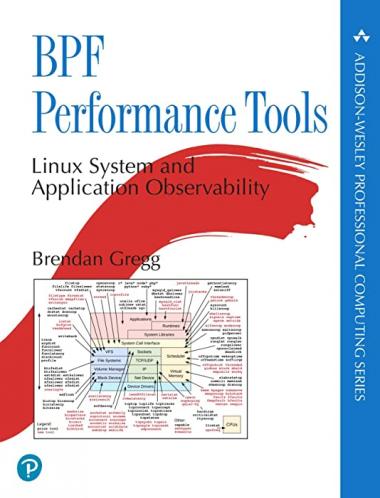Description
Product Description Use BPF Tools to Optimize Performance, Fix Problems, and See Inside Running Systems
BPF-based performance tools give you unprecedented visibility into systems and applications, so you can optimize performance, troubleshoot code, strengthen security, and reduce costs. BPF Performance Tools: Linux System and Application Observability is the definitive guide to using these tools for observability.
Pioneering BPF expert Brendan Gregg presents more than 150 ready-to-run analysis and debugging tools, expert guidance on applying them, and step-by-step tutorials on developing your own. You’ll learn how to analyze CPUs, memory, disks, file systems, networking, languages, applications, containers, hypervisors, security, and the kernel. Gregg guides you from basic to advanced tools, helping you generate deeper, more useful technical insights for improving virtually any Linux system or application.
• Learn essential tracing concepts and both core BPF front-ends: BCC and bpftrace
• Master 150+ powerful BPF tools, including dozens created just for this book, and available for download
• Discover practical strategies, tips, and tricks for more effective analysis
• Analyze compiled, JIT-compiled, and interpreted code in multiple languages: C, Java, bash shell, and more
• Generate metrics, stack traces, and custom latency histograms
• Use complementary tools when they offer quick, easy wins
• Explore advanced tools built on BPF: PCP and Grafana for remote monitoring, eBPF Exporter, and kubectl-trace for tracing Kubernetes
• Foreword by Alexei Starovoitov, creator of the new BPF
BPF Performance Tools will be an indispensable resource for all administrators, developers, support staff, and other IT professionals working with any recent Linux distribution in any enterprise or cloud environment.
From the Back Cover BPF and related observability tools give software professionals and students alike unprecedented visibility into software, helping them analyze operating system and application performance, troubleshoot code, and strengthen security. BPF Performance Tools: Linux System and Application Observability is the industry’s most comprehensive guide to using these tools for observability. Brendan Gregg, author of the industry’s definitive guide to system performance, introduces powerful new methods and tools for doing analysis that leads to more robust, reliable, and safer code.
This authoritative guide: - Explores a wide spectrum of software and hardware targets
- Thoroughly covers open source BPF tools from the Linux Foundation iovisor project’s bcc and bpftrace repositories
- Summarizes performance engineering and kernel internals you need to understand
- Provides and discusses 150+ bpftrace tools, including 80 written specifically for this book: tools you can run as-is, without programming – or customize and develop further, using diverse interfaces and the bpftrace front-end
Students will learn how to use BPF (eBPF) tracing tools to analyze CPUs, memory, disks, file systems, networking, languages, applications, containers, hypervisors, security, and the Linux kernel. Students will move from basic to advanced tools and techniques, producing new metrics, stack traces, custom latency histograms, and more. It’s like having a superpower: with Gregg’s guidance and tools, students can analyze virtually everything that impacts system performance, so they can improve virtually any Linux operating system or application. - Deeper, more in-depth coverage than any other eBPF resource
- Quickly analyze everything that impacts Linux system performance: ask questions and get fast answers in production environments
- Learn by example, with tools you can use to find performance wins and then customize for even more power
- Covers invaluable, in-demand technology: eBPF was the subject of over two dozen talks at the recent Linux Plumbers developer’s conference
- Downloadable source code includes 80+ new BPF analysis tools created for this book
Use BPF/eBPF tracing and observability tools to improve system performance, reduce costs, resolve software issues, and gain unprecedented visibility into running systems- Deeper, more in-depth coverage than any other eBPF resource
- Quickly analyze everything that impacts Linux system performance: ask questions and get fast answers in production environments
- Learn by example, with tools you can use to find performance wins and then customize for even more power
- Covers invaluable, in-demand technology: eBPF was the subject of over two dozen talks at the recent Linux Plumbers developer’s conference
- Downloadable source code includes 80+ new BPF analysis tools created for this book
About the Author Brendan Gregg, Netflix senior performance engineer, is a major contributor to BPF (eBPF) who has helped develop and maintain both main BPF front-ends, pioneered BPF's use for observability, and created dozens of BPF-based performance analysis tools. Previously a kernel engineer and professional technical trainer, his books include the best-seller Systems Performance: Enterprise and the Cloud.
Read more Features & details Features - Highlight, take notes, and search in the book
- In this edition, page numbers are just like the physical edition
Product information | Publisher |
Addison-Wesley Professional; 1st edition (December 13, 2019) | | Language |
English | | Paperback |
880 pages | | ISBN-10 |
0136554822 | | ISBN-13 |
978-0136554820 | | Item Weight |
3.04 pounds | | Dimensions |
7 x 1.85 x 9.15 inches |
| Best Sellers Rank |
#79,522 in Books (See Top 100 in Books)
#6 in Computer Performance Optimization
#17 in Unix Operating System
#42 in Computer Operating Systems (Books)
| | Customer Reviews | 4.8 out of 5 stars 129Reviews |
Brief content visible, double tap to read full content.Full content visible, double tap to read brief content. Help others learn more about this product by uploading a video! Upload video  Brief content visible, double tap to read full content.Full content visible, double tap to read brief content.
Brief content visible, double tap to read full content.Full content visible, double tap to read brief content.
Customer reviews4.8 out of 54.8 out of 5129 global ratings
Top reviews from the United States
 Harry J. Foxwell, PhD5.0 out of 5 starsVerified Purchase
Essential reference for understanding Linux kernel and application performance
Reviewed in the United States on January 3, 2020
Teaching and learning about operating system theory is one thing, while actually using an OS, verifying that it is doing what theory specifies, both safely and efficiently, is quite another. Understanding how a particular OS performs is a daunting task, especially in the...
See more
Teaching and learning about operating system theory is one thing, while actually using an OS, verifying that it is doing what theory specifies, both safely and efficiently, is quite another. Understanding how a particular OS performs is a daunting task, especially in the current world of multicore processors, virtualization, and massive scale. Powerful and usable observability tools are needed to examine every aspect of OS behaviour. Such tools have evolved dramatically in the past two decades, driven by commercial efforts like DTrace for Solaris and its open-source adoption and adaptation to other operating sytems like FreeBSD, OS X, Linux, and even Windows(!). Harry J. Foxwell, PhD5.0 out of 5 starsVerified Purchase
Essential reference for understanding Linux kernel and application performance
Reviewed in the United States on January 3, 2020
Teaching and learning about operating system theory is one thing, while actually using an OS, verifying that it is doing what theory specifies, both safely and efficiently, is quite another. Understanding how a particular OS performs is a daunting task, especially in the...
See more
Teaching and learning about operating system theory is one thing, while actually using an OS, verifying that it is doing what theory specifies, both safely and efficiently, is quite another. Understanding how a particular OS performs is a daunting task, especially in the current world of multicore processors, virtualization, and massive scale. Powerful and usable observability tools are needed to examine every aspect of OS behaviour. Such tools have evolved dramatically in the past two decades, driven by commercial efforts like DTrace for Solaris and its open-source adoption and adaptation to other operating sytems like FreeBSD, OS X, Linux, and even Windows(!).
Brendan Gregg is a leader in OS performance theory and practice, well-known for his earlier work and publications on DTrace; his diagnostic and graphical tools are now essential for discovering bugs and bottlenecks in OS and application execution. His latest volume, BPF Performance Tools, in size and scope is a veritable encyclopedia of OS observability methods and programs for both the Linux kernel itself and its application execution environment. Exploiting his insights gained from DTrace, Gregg has extended and enhanced BPF (Berkeley Packet Filter) technology, creating a massive collection of probes and monitors used to dynamically trace the execution of compute, memory, network, and I/O functions.
Linux system administrators, kernel hackers, security researchers, and application developers should thoroughly study and keep Gregg’s reference handy to both diagnose performance problems and to learn how to avoid them in the first place. Anyone teaching about operating systems, both in industry and in academia, should enhance their instruction with the invaluable practical advice and techniques in this thorough and comprehensive text. Gregg also provides additional material, source code, and examples on the book’s companion web site. And to help understand the observability purpose of each of the standard and BPF-specific Linux tools, Gregg includes helpful diagrams showing which parts of the kernel each tool addresses.
11 people found this helpful
Helpful
 James Mauro5.0 out of 5 starsVerified Purchase
An indispensable must-have if Linux is your day job
Reviewed in the United States on December 7, 2019
Computer systems are inherently complex, as are some of the powerful tools we use for root-causing performance issues and debugging pathological system and/or application behavior. What Brendan has accomplished with BPF Performance Tools is no small feat; making a complex...
See more
Computer systems are inherently complex, as are some of the powerful tools we use for root-causing performance issues and debugging pathological system and/or application behavior. What Brendan has accomplished with BPF Performance Tools is no small feat; making a complex topic accessible to all, while at the same time meeting the needs of the experienced and the experts that seek real technical depth. Novice, expert and everyone in between will benefit from the information contained in this book, and the vast array of tools created by Brendan and others that leverage the power of this technology. The quality of the content, and organization of the material is such that you can literally pick this book up and hit the ground running, tearing into your latest Linux performance challenge in no time at all. Interested in understanding more about how such a powerful and complex technology is implemented? It''s in there. Interested in leveraging BPF to develop your own custom tools? It''s in there. Interested in understanding how the suite of existing tools work, and what area of the kernel they expose? It''s in there. No stone is left unturned, the book contains complete coverage of all hardware subsystems (CPU''s, Memory, etc) and Linux kernel components (file systems, virtual memory, networking, etc). The icing on the cake are pearls of wisdom based on the author''s work and experience in approaching system performance problems. James Mauro5.0 out of 5 starsVerified Purchase
An indispensable must-have if Linux is your day job
Reviewed in the United States on December 7, 2019
Computer systems are inherently complex, as are some of the powerful tools we use for root-causing performance issues and debugging pathological system and/or application behavior. What Brendan has accomplished with BPF Performance Tools is no small feat; making a complex...
See more
Computer systems are inherently complex, as are some of the powerful tools we use for root-causing performance issues and debugging pathological system and/or application behavior. What Brendan has accomplished with BPF Performance Tools is no small feat; making a complex topic accessible to all, while at the same time meeting the needs of the experienced and the experts that seek real technical depth. Novice, expert and everyone in between will benefit from the information contained in this book, and the vast array of tools created by Brendan and others that leverage the power of this technology. The quality of the content, and organization of the material is such that you can literally pick this book up and hit the ground running, tearing into your latest Linux performance challenge in no time at all. Interested in understanding more about how such a powerful and complex technology is implemented? It''s in there. Interested in leveraging BPF to develop your own custom tools? It''s in there. Interested in understanding how the suite of existing tools work, and what area of the kernel they expose? It''s in there. No stone is left unturned, the book contains complete coverage of all hardware subsystems (CPU''s, Memory, etc) and Linux kernel components (file systems, virtual memory, networking, etc). The icing on the cake are pearls of wisdom based on the author''s work and experience in approaching system performance problems.
Whether Linux is your day job, or you''re a computer science student interested in operating systems and dynamic tracing technologies, BPF Performance Tools needs to be on your desk. Right next to the keyboard. Very highly recommended.
10 people found this helpful
Helpful
 Rafael Cepeda5.0 out of 5 starsVerified Purchase
several bpftrace one-liners
Reviewed in the United States on January 4, 2020
Gregg explains the history and evolution of BPF (just enough). He graphically shows BCC, BPF, and bpftrace architecture and bpf tools. He describes which kernel mechanisms make this possible (mostly kprobes and uprobes). He highlights the pros and cons of dynamic vs static...
See more
Gregg explains the history and evolution of BPF (just enough). He graphically shows BCC, BPF, and bpftrace architecture and bpf tools. He describes which kernel mechanisms make this possible (mostly kprobes and uprobes). He highlights the pros and cons of dynamic vs static instrumentation and example usage. There''s a plethora of bpftrace one-liners which show the tool''s versatility. (The tool parallels AWK which feels at home in the UNIX toolbox.)
6 people found this helpful
Helpful Rafael Cepeda5.0 out of 5 starsVerified Purchase
several bpftrace one-liners
Reviewed in the United States on January 4, 2020
Gregg explains the history and evolution of BPF (just enough). He graphically shows BCC, BPF, and bpftrace architecture and bpf tools. He describes which kernel mechanisms make this possible (mostly kprobes and uprobes). He highlights the pros and cons of dynamic vs static...
See more
Gregg explains the history and evolution of BPF (just enough). He graphically shows BCC, BPF, and bpftrace architecture and bpf tools. He describes which kernel mechanisms make this possible (mostly kprobes and uprobes). He highlights the pros and cons of dynamic vs static instrumentation and example usage. There''s a plethora of bpftrace one-liners which show the tool''s versatility. (The tool parallels AWK which feels at home in the UNIX toolbox.)
6 people found this helpful
Helpful
 John5.0 out of 5 starsVerified Purchase
Absolutely indispensable for Linux/Cloud performance analysis
Reviewed in the United States on March 6, 2020
BPF is the new hotness in the Linux world. It is a mind-bending technology. Bredan''s book explains it lucidly, and provides a great background of the technology, and specific tips on how to debug specific subsystems like memory, CPU, ... Absolutely...
See more
BPF is the new hotness in the Linux world. It is a mind-bending technology. John5.0 out of 5 starsVerified Purchase
Absolutely indispensable for Linux/Cloud performance analysis
Reviewed in the United States on March 6, 2020
BPF is the new hotness in the Linux world. It is a mind-bending technology. Bredan''s book explains it lucidly, and provides a great background of the technology, and specific tips on how to debug specific subsystems like memory, CPU, ... Absolutely...
See more
BPF is the new hotness in the Linux world. It is a mind-bending technology.
Bredan''s book explains it lucidly, and provides a great background of the technology, and specific tips on how to debug specific subsystems like memory, CPU, ...
Absolutely incredible book. Every software engineer will learn a lot from this.
2 people found this helpful
Helpful
 Harry5.0 out of 5 starsVerified Purchase
Voice from top expert
Reviewed in the United States on May 14, 2020
A must have if you''re feeling interested in bpf. I had wasted a lot time trying to collect pieces of information from internet.
2 people found this helpful
Helpful Harry5.0 out of 5 starsVerified Purchase
Voice from top expert
Reviewed in the United States on May 14, 2020
A must have if you''re feeling interested in bpf. I had wasted a lot time trying to collect pieces of information from internet.
2 people found this helpful
Helpful
 Justin Miller5.0 out of 5 starsVerified Purchase
The Seminal Book on Linux Performance
Reviewed in the United States on March 6, 2020
Amazing book written by a master of his craft at the top of his game. Worth it’s weight in gold with deep explanations of Linux performance, subsystems, and provides a plethora of tools to dive down deep.
2 people found this helpful
Helpful Justin Miller5.0 out of 5 starsVerified Purchase
The Seminal Book on Linux Performance
Reviewed in the United States on March 6, 2020
Amazing book written by a master of his craft at the top of his game. Worth it’s weight in gold with deep explanations of Linux performance, subsystems, and provides a plethora of tools to dive down deep.
2 people found this helpful
Helpful
 Amazon Customer5.0 out of 5 starsVerified Purchase
Performance engineering guide
Reviewed in the United States on March 4, 2020
An extremely helpful book for anybody who works in the performance engineering domain.
2 people found this helpful
Helpful Amazon Customer5.0 out of 5 starsVerified Purchase
Performance engineering guide
Reviewed in the United States on March 4, 2020
An extremely helpful book for anybody who works in the performance engineering domain.
2 people found this helpful
Helpful
 Timothy Cullen5.0 out of 5 starsVerified Purchase
This book tells what you want to know.
Reviewed in the United States on January 11, 2021
Especially a lot of things you didn''t know that you wanted to know.
Helpful Timothy Cullen5.0 out of 5 starsVerified Purchase
This book tells what you want to know.
Reviewed in the United States on January 11, 2021
Especially a lot of things you didn''t know that you wanted to know.
Helpful
Top reviews from other countries
Translate all reviews to English Mario Oliva
5.0 out of 5 starsVerified Purchase
LIBRO INDISPENSABLE PARA TODO SYSADMIN
Reviewed in Mexico on January 28, 2020 Mario Oliva
5.0 out of 5 starsVerified Purchase
LIBRO INDISPENSABLE PARA TODO SYSADMIN
Reviewed in Mexico on January 28, 2020
-
-
-
Este libro es una referencia indispensable si trabajas en IT y eres SysAdmin. No es requisito saber programar en el ambiente Linux pero es deseable tener fundamentos de arquitectura del kernel y haber programado en algún lenguage de bajo nivel para sacarle el máximo...See moreEste libro es una referencia indispensable si trabajas en IT y eres SysAdmin. No es requisito saber programar en el ambiente Linux pero es deseable tener fundamentos de arquitectura del kernel y haber programado en algún lenguage de bajo nivel para sacarle el máximo provecho a todo el material que se presenta.
Este libro es una referencia indispensable si trabajas en IT y eres SysAdmin. No es requisito saber programar en el ambiente Linux pero es deseable tener fundamentos de arquitectura del kernel y haber programado en algún lenguage de bajo nivel para sacarle el máximo provecho a todo el material que se presenta.
Translate review to English Adrian
5.0 out of 5 starsVerified Purchase
Contenido excelente, muy detallado.
Reviewed in Mexico on July 11, 2020
El contenido de maravilla, la versión impresa no está a color, y varios flamecharts y diagramas no se aprecian muy bien en escala de grises, por lo demás uno de los mejores libros sobre el tema.
El contenido de maravilla, la versión impresa no está a color, y varios flamecharts y diagramas no se aprecian muy bien en escala de grises, por lo demás uno de los mejores libros sobre el tema.
Translate review to English Adrian
5.0 out of 5 starsVerified Purchase
Contenido excelente, muy detallado.
Reviewed in Mexico on July 11, 2020
El contenido de maravilla, la versión impresa no está a color, y varios flamecharts y diagramas no se aprecian muy bien en escala de grises, por lo demás uno de los mejores libros sobre el tema.
El contenido de maravilla, la versión impresa no está a color, y varios flamecharts y diagramas no se aprecian muy bien en escala de grises, por lo demás uno de los mejores libros sobre el tema.
Translate review to English Joe Banana
1.0 out of 5 starsVerified Purchase
Not worth the money and he weight
Reviewed in Canada on March 12, 2021
Not useful. Just a bunch of program listing and generic statments.
Not useful. Just a bunch of program listing and generic statments. Joe Banana
1.0 out of 5 starsVerified Purchase
Not worth the money and he weight
Reviewed in Canada on March 12, 2021
Not useful. Just a bunch of program listing and generic statments.
Not useful. Just a bunch of program listing and generic statments.
See all reviews
How customer reviews and ratings workCustomer Reviews, including Product Star Ratings help customers to learn more about the product and decide whether it is the right product for them.Learn more how customers reviews work on Amazon
Brief content visible, double tap to read full content.Full content visible, double tap to read brief content.
Brief content visible, double tap to read full content.Full content visible, double tap to read brief content.

|





